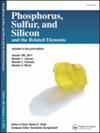石英资源在高温下的碳热还原行为
IF 1.6
4区 化学
Q4 CHEMISTRY, INORGANIC & NUCLEAR
Phosphorus, Sulfur, and Silicon and the Related Elements
Pub Date : 2025-08-21
DOI:10.1080/10426507.2025.2551102
引用次数: 0
摘要
工业硅是可再生能源领域的重要原材料,如太阳能光伏板和硅基阳极材料。然而,它的生产过程是高度能源密集型的,每生产一吨要消耗11到13兆瓦时(MWh)的电力,占总生产成本的25%以上。因此,提高生产技术和降低能源消耗是未来发展的重点。研究表明,不同地区的硅源在反应性上存在显著差异,直接影响工业硅的生产效率。碳硅复合团聚体(CSCA)技术有助于有效地利用资源,改善埋弧炉内的温度分布,提高碳化硅和氧化硅的形成速度。本研究评估了不同硅源在不同温度、碳硅比和粒径下的反应行为,并计算了活化能。根据反应性匹配评估,Q2和Q3石英已被确定为工业硅生产的理想原料。这三种石英的活化能分别为269 kJ·mol−1、319 kJ·mol−1和341 kJ·mol−1。这些发现为工业硅行业选择原料和优化CSCA生产工艺提供了重要的见解。本文章由计算机程序翻译,如有差异,请以英文原文为准。
Carbothermal reduction behavior of quartz resources at elevated temperatures
Industrial silicon is a vital raw material in renewable energy sectors, such as solar photovoltaic panels and silicon-based anode materials. However, its production process is highly energy-intensive, consuming as much as 11 to 13 megawatt-hours (MWh) of electricity for every ton produced, which accounts for over 25% of the total production cost. Therefore, improving production techniques and reducing energy consumption are key focal points for future development. Research indicates that silicon sources from different regions exhibit significant differences in reactivity, directly affecting the production efficiency of industrial silicon. The Carbon-Silicon Composite Agglomerate (CSCA) technology contributes to effective resource utilization, improves temperature distribution within submerged arc furnaces, and enhances the formation rates of silicon carbide and silicon oxide. This study evaluates the reaction behavior of different silica sources under varying temperatures, carbon-silicon ratios, and particle sizes, along with calculations of activation energy. Based on the reactivity matching assessment, Q2 and Q3 quartz have been identified as ideal raw materials for industrial silicon production. The activation energies for these three quartz types are 269 kJ·mol−1, 319 kJ·mol−1, and 341 kJ·mol−1, respectively. These findings provide significant insights for the industrial silicon industry in selecting raw materials and optimizing the CSCA production process.
求助全文
通过发布文献求助,成功后即可免费获取论文全文。
去求助
来源期刊
CiteScore
2.60
自引率
7.70%
发文量
103
审稿时长
2.1 months
期刊介绍:
Phosphorus, Sulfur, and Silicon and the Related Elements is a monthly publication intended to disseminate current trends and novel methods to those working in the broad and interdisciplinary field of heteroatom chemistry.

 求助内容:
求助内容: 应助结果提醒方式:
应助结果提醒方式:


